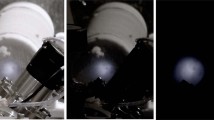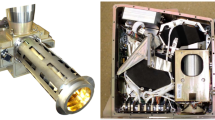Abstract
Europa and Callisto are two “extreme members” in a sequence of the Galilean ice satellites formed at different distances from Jupiter. The difference in their mean density probably reflects the material density gradient that appeared even in the subplanetary disk of Jupiter. At the same time, general peculiarities in the composition of the surfaces of Europa and Callisto apparently characterize the accumulated effect of all subsequent evolutionary processes, including current volcanic activity on the satellite Io and its ionized material transfer in Jovian magnetosphere, as well as chemical reactions taking place under low-temperature (within ~90–130 K) and irradiation conditions. In 2016–2017, we observed the leading and trailing hemispheres of Europa and Callisto in the spectral range of 1.0–2.5 μm at 2-m telescope of Caucasian Mountain Observatory (CMO) of Sternberg Astronomical Institute (SAI) of Moscow State University (MSU). We found that, on a global scale, Europa and Callisto exhibit similar spectral characteristics and, particularly, the maxima in the distributions of sulfuric acid hydrate in the trailing hemispheres of the both moons, which agrees with the data of previous measurements. This can be considered as evidence for general ion implantation on these and other moons in the radiation belts of Jupiter. Moreover, our spectral data suggest that water ice and hydrates (clathrates) of other compounds are dominant or abundant in the leading hemispheres of Europa and Callisto. Specifically, we detected a weak absorption band of CH4 clathrate centered at ~1.67 μm in the reflectance spectra of the leading (the band is more intense) and trailing (the band is less intense) hemispheres of Europa. Weak signs of the same absorption band are also in the reflectance spectra of Callisto measured at its different orientations.
Similar content being viewed by others
References
Anderson, J.D., Lau, E.L., Sjogren, W.L., Schubert, G., and Moore, W.B., Europa’s differentiated internal structure: Inferences from two Galileo encounters, Science, 1997a, vol. 276, pp. 1236–1239.
Anderson, J.D., Lau, E.L., Sjogren, W.L., Schubert, G., and Moore, W.B., Gravitational evidence for an undifferentiated Callisto, Nature, 1997b, vol. 387, pp. 264–266.
Bagenal, F., Empirical model of the Io plasma torus: Voyager measurements, J. Geophys. Res., 1994, vol. 99, pp. 11043–11062.
Bagenal, F., Ionization source near Io from Galileo wake data, Geophys. Res. Lett., 1997, vol. 24, pp. 2111–2114.
Bagenal, F. and Sullivan, J.D., Direct plasma measurements in the Io torus and inner magnetosphere of Jupiter, J. Geophys. Res., 1981, vol. 86, pp. 8447–8466.
Bolton, S.J., Thorne, R.M., Gurnett, D.A., Kurth, W.S., and Williams, D.J., Enhanced whistler-mode emissions: Signatures of interchange motion in the Io torus, Geophys. Res. Lett., 1997, vol. 24, pp. 2123–2126.
Brunetto, R., Caniglia, G., Baratta, G.A., and Palumbo, M.E., Integrated near-infrared band strengths of solid CH4 and its mixtures with N2, Astrophys. J., 2008, vol. 686, pp. 1480–1485.
Busarev, V.V., Spectrophotometry of atmosphereless celestial bodies of the solar system, Sol. Syst. Res., 1999, vol. 33, no. 2, pp. 120–129.
Busarev, V.V., Characteristic features in the spectra of Europa, Ganymede, and Callisto, Sol. Sys. Res., 2014, vol. 48, no. 1, pp. 48–61.
Calvin, W. and Clark, R., Modeling the reflectance spectrum of Callisto 0.25 to 4.1 µm, Icarus, 1991, vol. 89, pp. 305–317.
Calvin, W. and Clark, R., Spectral distinctions between the leading and trailing hemispheres of Callisto: New observations, Icarus, 1993, vol. 104, pp. 69–78.
Carlson, R., Smythe, W., Baines, K., et al., Near-infrared spectroscopy and spectral mapping of Jupiter and the Galilean satellites: Results from Galileo’s initial orbit, Science, 1996, vol. 274, pp. 385–388.
Carlson, R.W., Johnson, R.E., and Anderson, M.S., Sulfuric acid on Europa and the radiolytic sulfur cycle, Science, 1999, vol. 286, pp. 97–99.
Carlson, R.W., Anderson, M.S., Mehlman, R., and Johnson, R.E., Distribution of hydrate on Europa: Further evidence for sulfuric acid hydrate, Icarus, 2005, vol. 149, pp. 461–471.
Carr, M.H., Belton, M.J.S., Chapman, C.R., et al., Evidence for a subsurface ocean on Europa, Nature, 1998, vol. 391, pp. 363–365.
Cooper, J.F., Johnson, R.E., Mauk, B.H., Garrett, H.B., and Gehrels, N., Energetic ion and electron irradiation of the icy Galilean satellites, Icarus, 2001, vol. 149, pp. 133–159.
Dalton, J.B., Prieto-Ballesteros, O., Kargel, J.S., Jamieson, C.S., Jolivet, J., and Quinn, R., Spectral comparison of heavily hydrated salts with disrupted terrains on Europa, Icarus, 2005, vol. 177, pp. 472–490.
Dalton, J.B. III, Cassidy, T., Paranicas, C., Shirley, J.H., Prockter, L.M., and Kamp, L.W., Exogenic controls on sulfuric acid hydrate production at the surface of Europa, Planet. Space Sci., 2013, vol. 77, pp. 45–63.
Dartois, E., Deboffle, D., and Bouzit, M., Methane clathrate hydrate infrared spectrum II. Near-infrared overtones, combination modes and cages assignments, Astron. Astrophys., 2010, vol. 514, no. A49.
Delitsky, M.L. and Lane, A.L., Chemical schemes for surface modification of icy satellites: A road map, J. Geophys. Res.: Planets, 1997, vol. 102, no. 7, pp. 16385–16390.
Delitsky, M.L. and Lane, A.L., Ice chemistry on the Galilean satellites, J. Geophys. Res.: Planets, 1998, vol. 103, no. 13, pp. 31391–31404.
Englezos, P., Clathrate hydrates, Ind. Eng. Chem. Res., 1993, vol. 32, pp. 1251–1274.
Greenberg, R., Tidal evolution of the Galilean satellites: A linearized theory, Icarus, 1981, vol. 46, pp. 415–423.
Greenberg, R., Geissler, P., and Pappalardo, R., Long term and “diurnal” tidal stresses on Europa, The 28th Lunar and Planetary Science Conf., Houston, 1997, no. 1855.
Hall, D.T., Strobel, D.F., Feldman, P.D., McGrath, M.A., and Weaver, H.A., Detection of an oxygen atmosphere on Jupiter’s moon Europa, Nature, 1995, vol. 373, pp. 677–679.
Hansen, G.B. and McCord, T.B., Amorphous and crystalline ice on the Galilean satellites: A balance between thermal and radiolytic processes, J. Geophys. Res.: Planets, 2004, vol. 109, p. E01012.
Javier, R., Heat flow and thermal state of the crust of the icy Galilean satellites, Earth, Moon, Planets, 2012, vol. 109, pp. 117–125.
Johnson, R.E. and Quickenden, T.I., Photolysis and radiolysis of water ice on outer Solar System bodies, J. Geophys. Res., 1997, vol. 102, pp. 10985–10996.
Johnson, R.E., Nelson, M.L., Nccord, T.B., and Gradie, J.C., Analysis of Voyager images of Europa–Plasma bombardment, Icarus, 1988, vol. 75, pp. 423–436.
Kane, M., Williams, D.J., Mauk, B.H., McEntire, R.W., and Roelof, E.C., Galileo Energetic Particles Detector measurements of hot ions in the neutral sheet region of Jupiter’s magnetodisk, Geophys. Res. Lett., 1999, vol. 26, pp. 5–8.
Khurana, K.K., Kivelson, M.G., Stevenson, D.J., Schubert, G., Russell, C.T., Walker, R.J., and Polanskey, C., Induced magnetic fields as evidence for subsurface oceans in Europa and Callisto, Nature, 1998, vol. 395, pp. 777–780.
Kuskov, O.L. and Kronrod, V.A., Core sizes and internal structure of the Earth’s and Jupiter’s satellites, Icarus, 2001, vol. 151, pp. 204–227.
Kuskov, O.L., Dorofeeva, V.A., Kronrod, V.A., and Makalkin, A.B., Sistemy Yupitera i Saturna. Formirovanie, sostav i vnutrennee stroenie krupnykh sputnikov (Jupiter and Saturn Systems: Development, Composition, and Internal Structure of Large Satellites), Marov, M.Ya., Ed., Moscow: LKI, 2009.
Lane, A.L. and Domingue, D.L., IUE’s view of Callisto: Detection of an SO2 absorption correlated to possible torus neutral wind alterations, Geophys. Res. Lett., 1997, vol. 24, pp. 1143–1146.
Langreth, D.C., Lundqvist, B.I., Chakarova-Käck, S.D., et al., A density functional for sparse matter, J. Phys.: Condens. Matter, 2009, vol. 21, no. 084203.
Ligier, N., Poulet, F., Carter, J., Brunetto, R., and Gourgeot, F., VLT/SINFONI observations of Europa: New insights into the surface composition, Astron. J., 2016, vol. 151, pp. 163–178.
Loeffler, M.J. and Hudson, R.L., Low-temperature thermal reactions between SO2 and H2O2 and their relevance to the Jovian icy satellites, Icarus, 2013, vol. 224, pp. 257–259.
Materese, C.K., Cruikshank, D.P., Sandford, S.A., Imanaka, H., and Nuevo, M., Ice chemistry on outer Solar System bodies: Electron radiolysis of N2–, CH4–, and CO-containing ices, Astrophys. J., 2015, vol. 812, no. 2, art. ID 150.
McCord, T.B., Hansen, G.B., Fanale, F.P., et al., Salts on Europa’s surface detected by Galileo’s Near Infrared Mapping Spectrometer, Science, 1998, vol. 280, pp. 1242–1245.
McKinnon, W.B. and Desai, S.S., Internal structures of the Galilean satellites: What can we really tell? The 34th Lunar and Planetary Science Conf., Houston, 2003, no. 2104.
Moore, W.B. and Schubert, G., The tidal response of Ganymede and Callisto with and without liquid water oceans, Icarus, 2003, vol. 166, pp. 223–226.
Nadjip, A.E., Tatarnikov, A.M., Toomey, D.W., Shatsky, N.I., Cherepashchuk, A.M., Lamzin, S.A., and Belinski, A.A., ASTRONIRCAM—the infrared camera-spectrograph for the 2.5-m telescope of SAI Caucasian observatory, Astrophys. Bull., 2017, vol. 72, no. 3, pp. 349–362.
Nelson, R.M., Lane, A.L., Matson, D.L., Veeder, G.J., Buratti, B.J., and Tedesco, E.F., Spectral geometric albedos of the Galilean satellites from 0.24 to 0.34 micrometers: Observations with the International Ultraviolet Explorer, Icarus, 1987, vol. 72, pp. 358–380.
Noll, K.S., Johnson, R.E., McGrath, M.A., and Caldwell, J.J., Detection of SO2 on Callisto with the Hubble Space Telescope, Geophys. Res. Lett., 1997, vol. 24, pp. 1139–1142.
Paranicas, C., Mauk, B.H., Ratliff, J.M., Cohen, C., and Johnson, R.E., The ion environment near Europa and its role in surface energetics, Geophys. Res. Lett., 2002, vol. 29, no. 5, p. 1074. doi 10.1029/2001GL014127
Pickles, A.J., A stellar spectral flux library: 1150–25000 A, Publ. Astron. Soc. Pac., 1998, vol. 110, p. 863.
Pospieszalska, M.K. and Johnson, R.E., Magnetospheric ion bombardment profiles of satellites: Europa and Dione, Icarus, 1989, vol. 78, pp. 1–13.
Roush, T., Pollack, J., Witteborn, F., Bregman, J., and Simpson, J., Ice and minerals on Callisto: A reassessmeont of the reflectance spectra, Icarus, 1990, vol. 86, pp. 355–382.
Sack, N.J., Johnson, R.E., Boring, J.W., and Baragiola, R.A., The effect of magnetospheric ion bombardment on the reflectance of Europa’s surface, Icarus, 1992, vol. 100, pp. 534–540.
Shematovich, V.I. and Johnson, R.E., Near-surface oxygen atmosphere at Europa, Adv. Space Res., 2001, vol. 27, pp. 1881–1888.
Shirley, J.H., Dalton, J.B. III, Prockter, L.M., and Kamp, L.W., Europa’s ridged plains and smooth low albedo plains: Distinctive compositions and compositional gradients at the leading side–trailing side boundary, Icarus, 2010, vol. 210, pp. 358–384.
Smythe, W.D., Spectra of hydrate frosts: Their application to the outer Solar system, Icarus, 1975, vol. 24, pp. 421–427.
Sparks, W.B., Hand, K.P., McGrath, M.A., Bergeron, E., Cracraft, M., and Deustua, S.E., Probing for evidence of plumes on Europa with HST/STIS, Astrophys. J., 2016, vol. 829, art. ID 121.
Spencer, J.R., Tamppari, L.K., Martin, T.Z., and Travis, L.D., Temperatures on Europa from Galileo photopolarimeter-radiometer: nighttime thermal anomalies, Science, 1999, vol. 284, pp. 1514–1516.
Spohn, T. and Schubert, G., Oceans in the icy Galilean satellites of Jupiter? Icarus, 2003, vol. 161, pp. 456–467.
Trumbo, S.K., Brown, M.E., and Butler, B.J., ALMA thermal observations of a proposed plume source region on Europa, Astron. J., 2017, vol. 154, pp. 148–148.
Urquhart, M.L. and Jakosky, B.M., Constraints on the solid-state greenhouse effect on the icy Galilean satellites, J. Geophys. Res., 1996, vol. 101, pp. 21169–21176.
van der Waals, J.H., The statistical mechanics of clathrate compounds, Trans. Faraday Soc., 1956, vol. 52, pp. 184–193.
Zahnle, K., Dones, L., and Levison, H.F., Cratering rates on the Galilean satellites, Icarus, 1998, vol. 136, pp. 202–222.
Zimmer, C., Khurana, K.K., and Kivelson, M.G., Subsurface oceans on Europa and Callisto: Constraints from Galileo Magnetometer observations, Icarus, 2000, vol. 147, pp. 329–347.
Zolotov, M.Yu. and Shock, E.L., Thermodynamic stability of hydrated salts on the surface of Europa, The 31st Lunar and Planetary Science Conf., Houston, 2000, no. 1843.
Author information
Authors and Affiliations
Corresponding author
Additional information
Original Russian Text © V.V. Busarev, A.M. Tatarnikov, M.A. Burlak, 2018, published in Astronomicheskii Vestnik, 2018, Vol. 52, No. 4, pp. 305–315.
Rights and permissions
About this article
Cite this article
Busarev, V.V., Tatarnikov, A.M. & Burlak, M.A. Comparison and Interpretation of Spectral Characteristics of the Leading and Trailing Hemispheres of Europa and Callisto. Sol Syst Res 52, 301–311 (2018). https://doi.org/10.1134/S0038094618030036
Received:
Published:
Issue Date:
DOI: https://doi.org/10.1134/S0038094618030036




